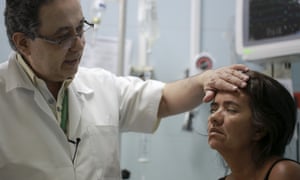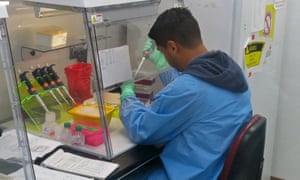Findings published as experts warn that paralysing illness could overwhelm intensive care wards of Latin America

Scientists have amassed the strongest evidence yet that the Zika virus can cause the serious neurological condition Guillain-Barré syndrome, and are warning that the potential number of cases of the paralysing illness could overwhelm the intensive care wards of Latin America.
The surge in the number of people with Guillain-Barré had been linked to Zika only on the basis of the timing – the cases have come to light as the viral infection has swept through Brazil and Colombia.
But now a paper in the Lancet medical journal from scientists who have investigated all 42 cases of Guillain-Barré syndrome (GBS) that occurred during an earlier Zika outbreak in French Polynesia provides the strongest evidence yet that the virus was the trigger.
Scientists from the Pasteur Institute in Paris analysed blood samples from those affected. “Most of the patients with GBS reported they had experienced symptoms of Zika virus infection on average six days before any neurological symptoms, and all carried Zika virus antibodies,” said Prof Arnaud Fontanet, the lead author of the paper.
They estimate that 24 people in every 100,000 infected with the Zika virus developed Guillain-Barré in French Polynesia, developing the muscle weakness that can progress to paralysis and involve the use of a ventilator to allow the patient to keep breathing. On the positive side, they found that once the acute phase was over, patients got better faster than usual. “Within three months, 57% of patients were able to walk,” said Fontanet.

But, he said, the study was a warning for regions experiencing Zika outbreaks. “At the peak of the epidemic, they may have to deal with many patients in intensive care units – where they are available, because they are not available everywhere,” he told the Guardian. “They [Guillain-Barré patients] monopolised the bed for 35 days.
“There may be two GBS patients in every 10,000 infected, but once they are in a bed, they are there for a month.”
The Zika outbreak in French Polynesia began in 2013 and ended the following year. Almost two-thirds of the population were infected. Because of the high standard of healthcare and laboratories – equivalent to that in France, said Fontanet – and data collection, there was very good information on the numbers of people affected and on the outcomes of those who were ill with GBS. All patients were seen in the same hospital by the same neurologists.
“I think in terms of epidemiological evidence, it would be very difficult to gather the same level of evidence that we had in French Polynesia,” Fontanet said.
Of the 42 people who developed Guillain-Barré, 88% had a Zika-like illness in the preceding days and all but one had Zika virus antibodies in their blood. All 42 had neutralising antibodies against the Zika virus, compared with 56% of a control group who were also given blood tests.
Most patients and controls also had antibodies showing they had been in contact with the dengue virus in the past. The researchers concluded that dengue virus infection did not increase the likelihood that people infected with Zika would develop Guillain-Barré.
There are still two missing pieces of the jigsaw. By the time people arrived in hospital, the acute viral infection was over – the virus lingers in the blood for only about five days, said Fontanet. They could only see the body’s response to the infection in the form of antibodies. The other piece is the absence of any molecular mechanism. Scientists do not know how Zika can cause Guillain-Barré, although they know that other viruses can trigger the immune system to attack nerve roots and peripheral nerves.
Dr Jeremy Farrar, the director of the Wellcome Trust, said the study provided the most compelling evidence to date of the link between Zika and Guillain-Barré. “The scale of the crisis unfolding in Latin America has taken us all by surprise, and we should be prepared for further unforeseen complications of Zika virus infection to emerge in the coming weeks and months,” he said. “What’s important now is that the global community comes together to focus research efforts on the many unanswered questions about the virus, and to share this information rapidly so that the knowledge gained can benefit patients as quickly as possible.”
Jimmy Whitworth, professor of international public health at the London School of Hygiene & Tropical Medicine said that if the experience in Latin America was the same as in French Polynesia, “this has implications for healthcare in countries with a Zika virus epidemic, as a proportion of those affected with Guillain-Barré syndrome will need breathing support on a ventilator for a while, and some cases do not recover fully from the syndrome and are left with disability.
“The results of our study support that Zika virus should be added to the list of infectious pathogens susceptible to cause Guillain-Barré syndrome. As Zika virus is spreading rapidly across the Americas, at-risk countries need to be prepared to have adequate intensive care beds capacity to manage patients with Guillain-Barré syndrome.”

















